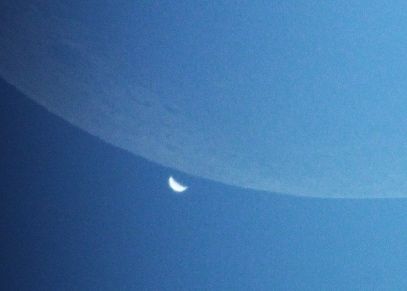The main celestial events of the last autumn month are associated with large planets. The largest of them, Jupiter, will be in the opposition configuration on November 3, when the conditions for its observations will be the best. On November 13, the opposition will be held by Uranus. You can try to see it with the naked eye in places with an unlit, clear sky, taking advantage of the absence of the Moon, which, by the way, will become the “culprit” of another interesting phenomenon: on November 9, it will shortly close Venus. Its disappearance will be visible throughout the territory of Ukraine (but only in the daytime sky).

On November 5, the opposition of the asteroid Melpomene will take place. It will occur less than two months after it passes the perihelion of its sufficiently elongated orbit. Due to this, it will come close enough to the Earth and will have a brightness of about 8th magnitude. On November 11, comet Lemmon, discovered in April this year, will fly near our planet. It passed perihelion on October 29. Its total brightness at this time can reach the 7th magnitude.
November 1
- Maximum activity of the Southern Taurid meteor shower (up to 20 meteors per hour)
November 3
- The Moon is 2° south of Pollux (β Gemini, 1,2ᵐ)
- Jupiter (-2.9ᵐ) is in opposition
November 5
- The Moon is in the last quarter phase
- Asteroid Melpomene (18 Melpomene, 8,0ᵐ) is in opposition, 0.863 AU (129 million km) from Earth
November 6
- The moon is at its apogee, 404,568 km from Earth
November 9
- The Moon occults Venus (-4.3ᵐ)
November 11
- The Moon is 2° north of Spica (α Virgo, 1.0ᵐ)
- Comet Lemmon (C/2023 H2 Lemmon, 7ᵐ) is 0.193 AU (28.9 million km) from Earth
November 12
- Maximum activity of the Northern Taurid meteor shower (up to 20 meteors per hour)
November 13
- New Moon
- Uranus (5,6ᵐ) is in opposition
November 17
- Maximum activity of the Leonid meteor shower (up to 20 meteors per hour)
November 18
- Mars in conjunction with the Sun
November 20
- The Moon is in the phase of the first quarter
- The Moon is 2° south of Saturn (0.8ᵐ)
November 21
- The Moon occults the star ψ¹ Aquarii (4,2ᵐ)
- The Moon is at perigee, 369,823 km from Earth
November 22
- The Moon is 4° east of Neptune (7,9ᵐ)
November 25
- The Moon is 3° north of Jupiter (-2.8ᵐ)
November 26
- The Moon is 3° west of Uranus (5,6ᵐ)
November 27
- Full moon
Follow us on Twitter to get the most interesting space news in time
https://twitter.com/ust_magazine
